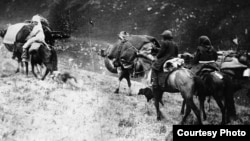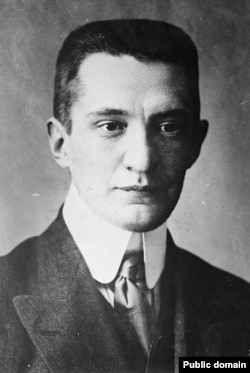Every year for the last 100 years, when the snow melts in the passes leading from Kyrgyzstan to China through the Tien-Shan (Heavenly) Mountains, evidence of one of the worst tragedies in the history of the Kyrgyz people is revealed.
Skeletal remains of tens of thousands of people and animals appear. These bones mark the trails the Kyrgyz and their herds took as they tried to escape Russian tsarist troops in 1916.
This year Kyrgyzstan's government is marking the 100th anniversary of the Great Urkun, the flight of the Kyrgyz people.
By 1916 Kyrgyz had already started to depart their homelands in what are now the Chui, Naryn, and Issyk-Kul provinces of Kyrgyzstan and also from Kyrgyz areas in what is now southeastern Kazakhstan. Russian records of the time, kept in Almaty, show 1,787 Kyrgyz families had left for China in 1915. From 1904 to 1914 another "approximately 10,000" Kyrgyz made the trip east over the mountains.
The reason was Russian colonization, St. Petersburg's version of Manifest Destiny, which had already seen Russia expand in some 200 years from the Urals to the Pacific Ocean. Russian settlers came to Central Asia in the latter half of the 19th century, on the heels of the tsar's army. The newcomers claimed ever more of the region's farmland.
In 1916, two years into World War I, St. Petersburg decided it would be necessary to conscript some 220,000 males, 19 to 43 years old, from Central Asia for military duty in Europe. Russian officials in Central Asia warned this would be an unpopular move among the Central Asians. In St. Petersburg, officials resolved on a compromise: the men would be conscripted but they would fill supporting tasks in the military, not engage in fighting.
That last part was not what was being said around the bazaars of Central Asia. The idea of fighting for a foreign conqueror in a war far away from home was unpopular enough. Most people in Central Asia in 1916 had very little concept of where Europe was or the reasons for the war there. Added to that was the rumor that the Central Asian Muslim conscripts would be forced to eat pork as part of their military rations (which did happen later to Central Asians in the Red Army). And the tsar's decree on conscription came into effect on June 25, a crucial time for Central Asia's farmers and herders to be engaged in the work that fed their families.
What many of the Central Asian people of that time did know was that there had been revolts in 1873-76 (by Kyrgyz Mullah Iskhak Hazan-uulu, i.e. "Pulat-khan"), and in May 1898 (the Andijon revolt in which Kyrgyz, Uzbeks, and Tajiks participated) against Russian colonialism.
Revolt broke out again -- and not only among the Kyrgyz, but among many of the other indigenous peoples of Central Asia as well.
It was a dilemma St. Petersburg could ill afford at that moment. Besides the war in Europe, Russian military planners were also concerned about Turkish leader Enver Pasha's dream of a pan-Turkic empire, with Central Asia's Muslims a part of it (something that concerned officials in British India at that time also). The order went out for Russian troops to crush the rebellion. The tactic was to be the same as that used by Russian General Mikhail Skobelev less than 40 years earlier. "I hold it as a principle that the duration of the peace is in direct proportion to the slaughter you inflict upon the enemy. The harder you hit them, the longer they remain quiet," Skobelev said after wiping out the last of the Turkmens' resistance in 1881.
It was the same in 1916.
Few Central Asians possessed firearms at the time, so resistance was practically futile. But the point was to hit them hard, even if the Central Asians were unable to resist.
The road from Bishkek to Kyrgyzstan's primary tourist area, the giant Lake Issyk-Kul, runs through Boom Canyon. In 1916, tens of thousands of Kyrgyz fled through this canyon. In a village called Belovodsk, 517 of the refugees, including women, children, and the elderly, were killed in one day. There are many other similar stories from the Urkun.
RFE/RL's Kyrgyz Service, known locally as Azattyk, for many years interviewed Kyrgyz who had made it to China with their families during the Urkun. One such person was Shaymerden Ibraimov, who at 80 years of age returned from China to Kyrgyzstan in 1995. "During the trip through the pass my great-grandfather Japarkul was killed, shot in the back by a [Russian] soldier. My grandfather did not have any way to bury him, so he was forced to leave the body," Ibraimov said.
We also have the words of Bayali Isakeev, who was about 19 years old when he fled with his family.
Isakeev wrote a book about the Urkun in 1933. Noting that winter had come early that year, he says: "We were forced to move on through the Bedel Pass at night. First I helped my mother and sister with a loaded camel make it along the narrow path. The path was slippery, almost entirely covered with snow, the slopes with ice. Below there were steep, yawning chasms. One false step meant certain death. I luckily led my mother and sister [along the path] and returned for my brother, who was halfway through the pass with our bull, loaded with our household possessions. On the way back we could see the crevasses filling up, nearly to the top in some places, with the bodies of camels, horses, cattle that had slipped over the side, and often people were there also."
Records at the time were poor, so it is unclear to this day how many Kyrgyz perished during the Urkun. Most scholars agree at least 150,000 died but some say the figure exceeds 250,000. Hundreds of thousands of the survivors poured into Chinese Turkestan.
Some in Russia protested the campaign. One was State Duma Deputy Aleksandr Kerensky, who called the tsarist actions in Central Asia a disgrace. After the tsar was deposed in 1917, a new government led by Kerensky came to power but, faced with myriad problems during its short tenure, that government could not even start to repair the damage done in Central Asia.
The Bolsheviks came to power in late 1917 and used the Urkun, and other tsarist repressions against Central Asian people, to their advantage by pledging to honor the fraternity of all the peoples of the newly created Soviet Union. The Bolshevik government called on the Kyrgyz to return.
Some did. Isakeev returned and rose through the ranks of the Communist Party to become a top official in the Kyrgyz Autonomous Soviet Socialist Republic and later Kyrgyz Soviet Socialist Republic (and also an editor at the Erkin Too newspaper). He was, however, arrested and shot in 1937 during the purges.
The Urkun has a special place in the memories of the Kyrgyz. After independence in 1991, groups were formed to go into the mountain passes during the summer, locate the remains of those who perished in 1916, and bury them. Artifacts were collected and brought to museums. A film is being made about the Urkun and is due to come out in theaters soon.
Kyrgyzstan's government and some organizations are sponsoring a series of events throughout 2016 to mark the 100th anniversary of the Urkun. None of the other Central Asian states are following this example despite the fact that so many of the peoples of the region were part of the events that took place 100 years ago.
Azattyk has done a wonderful job of creating a microsite to mark the 100th anniversary of the Urkun. Azattyk has photographs, pictures, copies of tsarist documents of the time and the stories of the some of the people who were alive during the Urkun, such as Ibraimov and Isakeev.
You can read the site in Kyrgyz or in Russian.
Much of what was written above was taken from the Azattyk website. Special thanks to Tynch Tchoroev, president of the Kyrgyz History Society international public association and former director of RFE/RL's Kyrgyz Service




